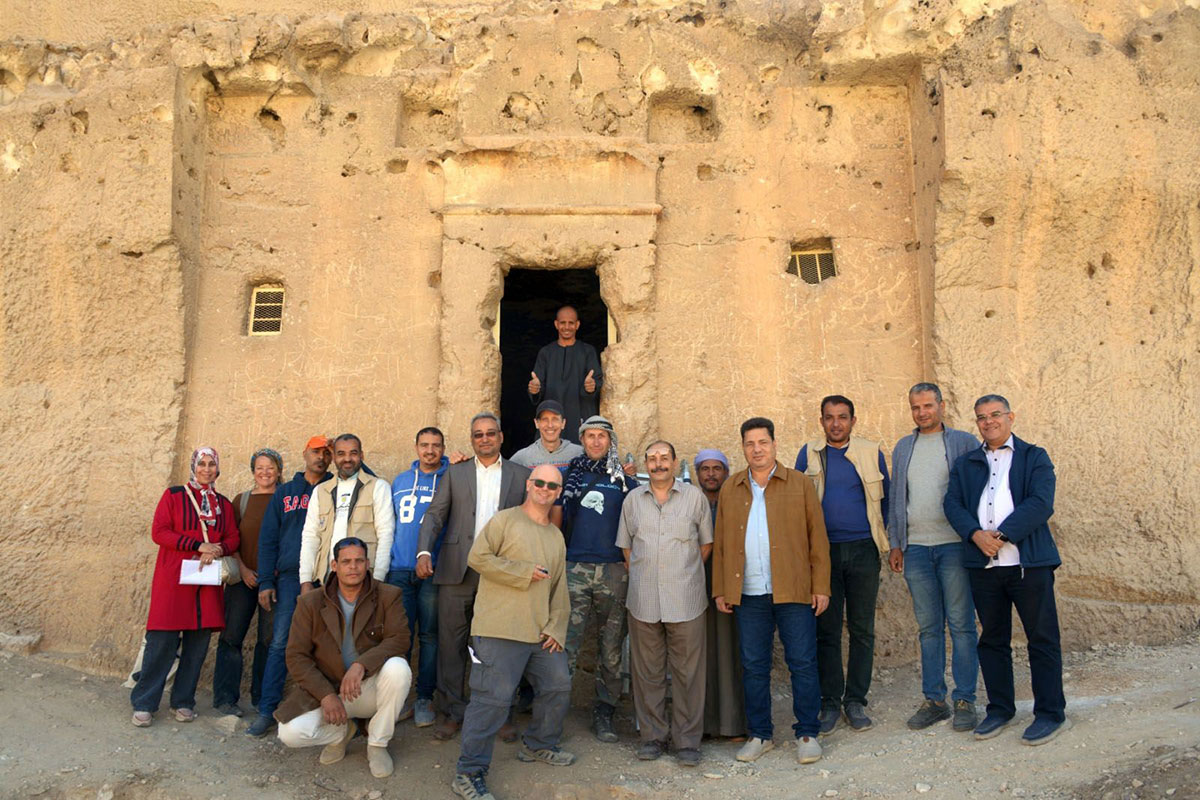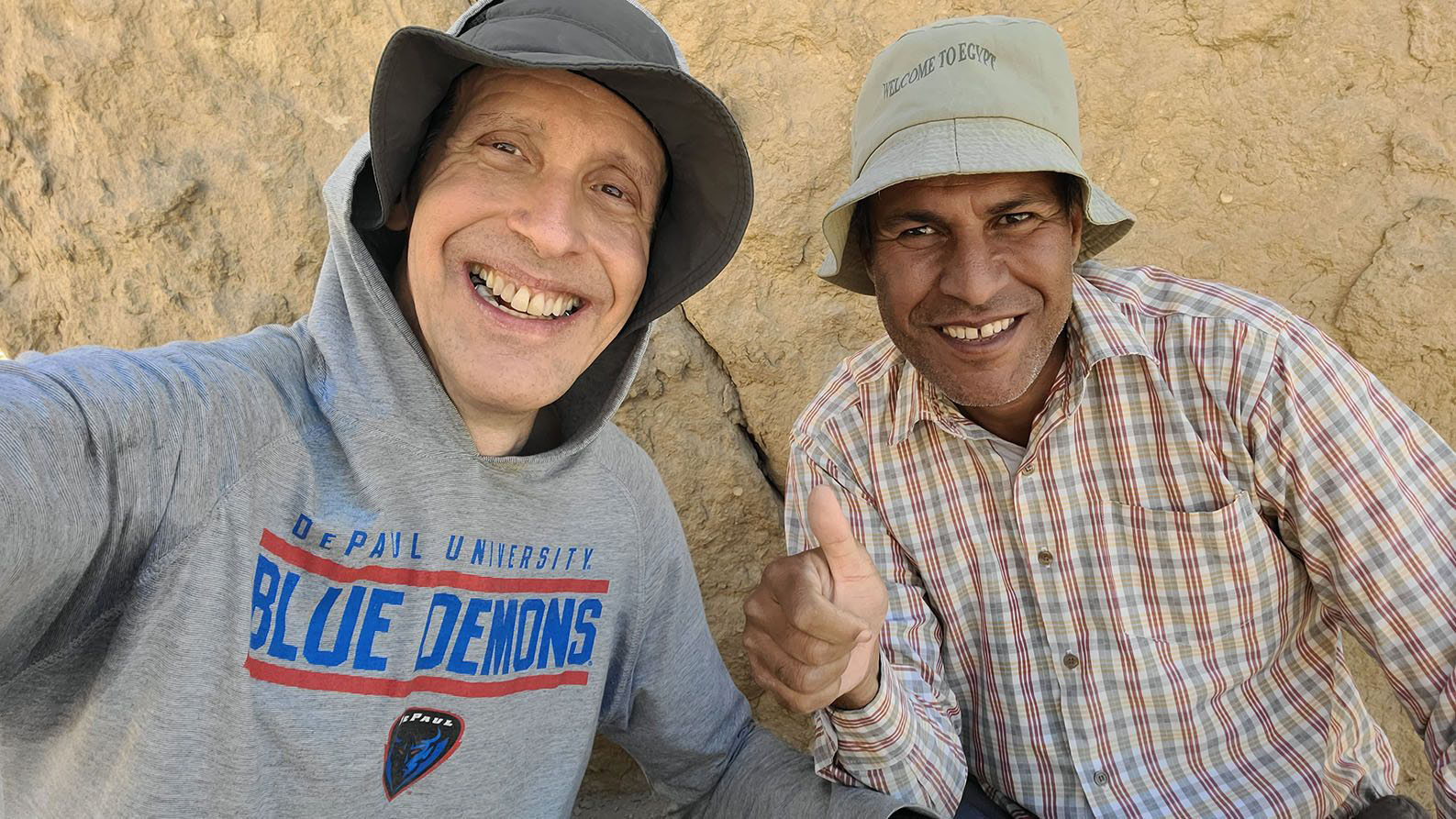 Scott Bucking’s ongoing field project, the Beni Hassan South Preservation Project, aims for a comprehensive understanding of the multi-period archaeology in Egypt's Eastern Desert (Photo courtesy of Scott Bucking)
Scott Bucking’s ongoing field project, the Beni Hassan South Preservation Project, aims for a comprehensive understanding of the multi-period archaeology in Egypt's Eastern Desert (Photo courtesy of Scott Bucking)In the vast mountains of Egypt’s Eastern Desert is a sacred landscape created thousands of years ago by the well-known pharaoh, Queen Hatshepsut. Among its key elements are a rock-cut temple dedicated to the lioness-headed deity Pakhet, and a highly decorated tomb likely belonging to a priest associated with the temple. As much as this landscape reveals about ancient Egyptian religion, its subsequent adaptive reuse by Christian and Islamic communities of Late Antiquity and the Middle Ages provides even longer-range insights into the complex, multicultural nature of Egyptian society.
DePaul's Scott Bucking, professor of ancient Mediterranean studies, has over a decade of experience conducting archaeological research in Egypt. Bucking’s ongoing field project, the Beni Hassan South Preservation Project, aims for a comprehensive understanding of the multi-period archaeology in this landscape, which borders the modern village of Beni Hassan al-Shuruq, just south of Middle Egypt’s provincial capital of Minya.
Beni Hassan al-Shuruq itself is a diverse community of Muslims and Coptic Christians who have for centuries been living next to this rich archaeological landscape.
“Our project commits to building partnerships in Egypt,” Bucking says. “We want to document and preserve the archaeology in this landscape, but we cannot do it effectively without engaging local communities, listening to what they need and understanding their interactions with this landscape.”
The American Research Center in Egypt funds Bucking’s project, and the project’s seasonal fieldwork relies on strong working partnerships with Egypt’s Minia University and the Ministry of Tourism and Antiquities. Last year, Bucking and his team began their conservation work on the decorated tomb likely associated with the sacred landscape Queen Hatshepsut created here in the 15th century BC. The team also discovered over 50 stone-built sites in the desert mountains thought to be part of a Late Antique hinterland.
“These desert sites may be a witness to the expansion of Egyptian Christianity and the monastic movement,” Bucking says. “The rather complex ancient settlement pattern within our project area includes the adaptive reuse of disused limestone quarries to install Christian churches.”
 Bucking works closely with experts from Egypt’s Minia University and the Ministry of Tourism and Antiquities (Photo courtesy of Scott Bucking)
Bucking works closely with experts from Egypt’s Minia University and the Ministry of Tourism and Antiquities (Photo courtesy of Scott Bucking)This fall, Bucking and his Minia University-based conservation team plan to finish conserving the decorated tomb near Hatshepsut’s rock-cut temple, and then inaugurate a program of conservation on the temple itself. Also planned is a study of the mud-brick architecture of medieval Islamic villages in the project area, with an eye toward preserving a mudbrick-built mosque in one of these villages.
As DePaul’s Faculty Fulbright Liaison and a current Humanities Center fellow, Bucking aims to connect DePaul with global communities and promote a better understanding of the human condition in both present and past contexts. These efforts are also at the heart of what takes place in Bucking’s classroom.
“My students use a satellite program that allows them to grapple with the problems of reconstructing the ancient Egyptian landscape from the modern one,” he says. “They’re getting hands-on experience working in these landscapes even though they’re not physically there, which is the goal of all my courses.”
Through this remote, satellite access, Bucking’s students have traversed ancient tombs and quarries, medieval Islamic towns and modern villages in his project area to piece together their histories. Bucking says having multiple students analyze his site is beneficial because they frequently point out features that may be overlooked. Bucking’s satellite platform also brings students to the Greater Cairo area where the famous Giza pyramids are located. The platform draws attention to some of the social, environmental and economic challenges of analyzing and preserving ancient monuments in modern-day urban spaces.
“The knowledge exchange between DePaul students is a very lively and dynamic thing even though we’re not physically bringing them to the sites,” Bucking says.
Future plans for Bucking’s site include opening it up for tourism, but the overarching goal is to create conversations about the complex relationships between the past and the present. Though recording and conserving ancient sites sheds light on the multiple histories of Egypt, Bucking says there are even more profound implications.
“I want to promote tolerance and understanding of different perspectives using the archaeological sites we work at,” Bucking says. “Beni Hassan al-Shuruq’s Christian and Islamic architecture create opportunities for inter-religious dialogue and can help seed a cultural heritage platform that reaches interested communities in Egypt and around the globe.”
Emily Diaz is a student assistant for internal communications in University Communications.